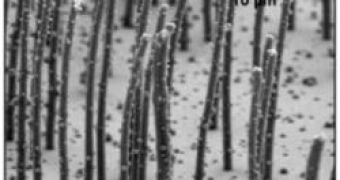Cilia is Latin for "eyelash", and they are thin, tail-like projections extending approximately 5-10 micrometers outwards from the body of a cell.
Eukaryotes, single-celled organisms, use cilia to move through liquid. In humans, they are found in the lining of the trachea (windpipe), where they sweep mucus and dirt out of the lungs, or moves the ovum (egg cell) from the ovary to the uterus.
US researchers Richard Superfine and colleagues at the University of North Carolina at Chapel Hill are developing artificial cilia, nanoscopic hair-like polymeric structures, that could explain how biological appendages work in the lung, hoping that their work could help other researchers develop better treatments for diseases that affect the respiratory system, like cystic fibrosis.
The artificial cilia are made of flexible polymer nanorods the same size as biological cilia (about 10 microns long and 0.2 microns wide), with similar physical properties. The nanorods were made by pouring liquid polydimethlsiloxane, containing iron oxide nanoparticles, into a mould. The mould itself is then chemically etched away, leaving hundreds of the nanorods protruding from a substrate.
Due to the fact that the nanorods contain iron oxide particles they can then be manipulated magnetically. An electromagnet below the array was used to bend and move them while a microscope positioned above monitored the movement.
The researchers used computer simulations to work out how to stimulate the nanorods magnetically so that they move in a similar way to the lung's cilia - staying straight when moving one way and curling as they move the other.
Their work offered an important contribution to understanding biology and how fields of cilia move fluids inside the body, such as inside the brain and in developing embryos.
However, it will still be a while until artificial cilia applications could replace biological tissue, so the next step of the research is to test the artificial cilia using viscous liquids that mimic the behavior of mucus inside the lung.

 14 DAY TRIAL //
14 DAY TRIAL //